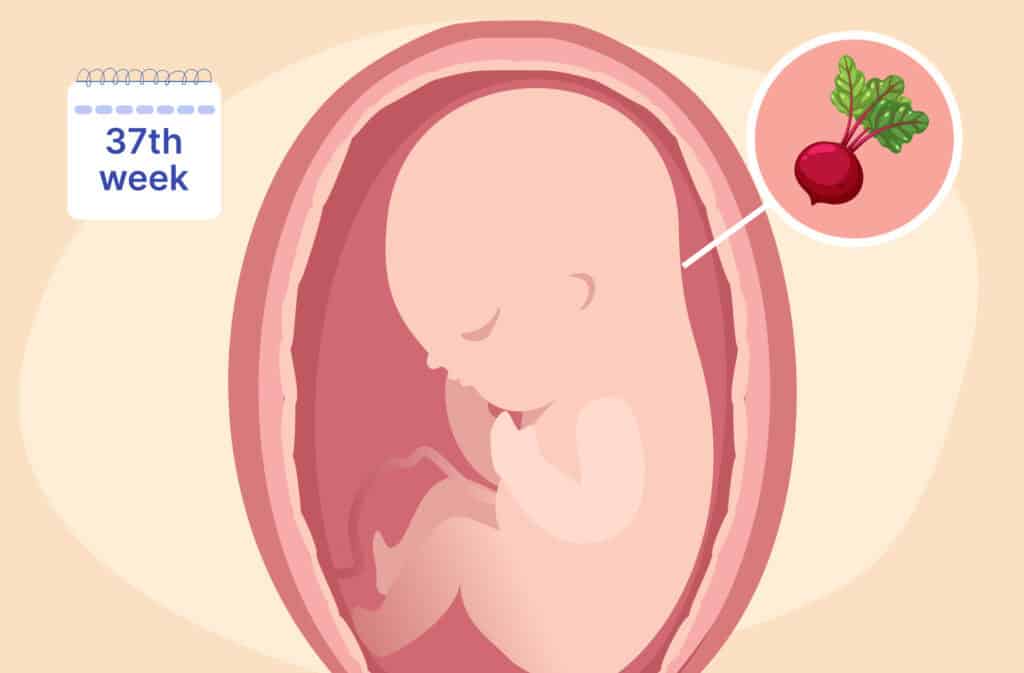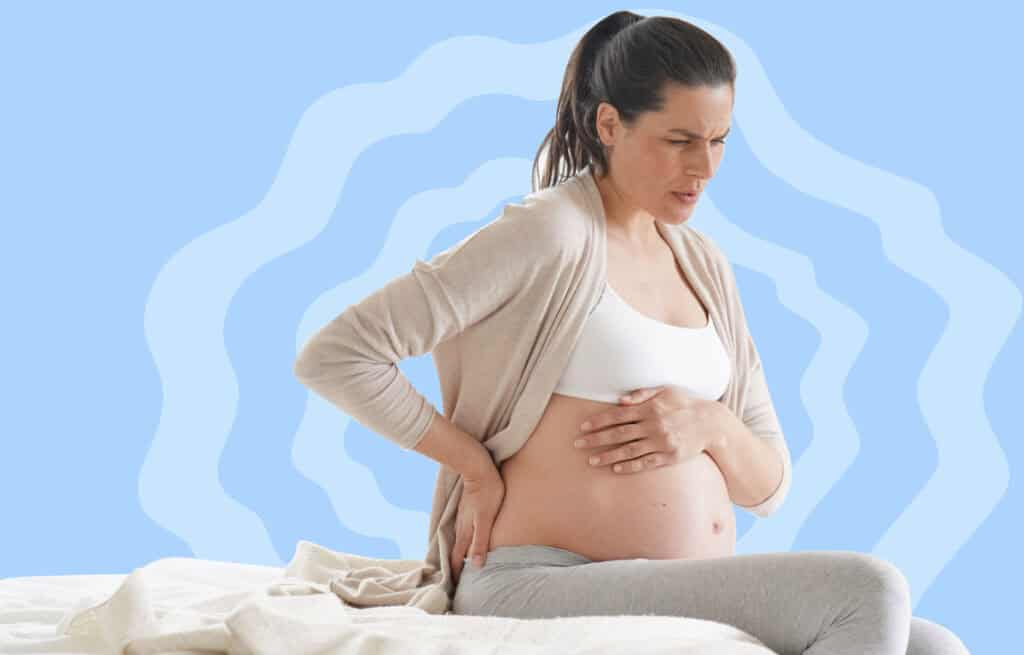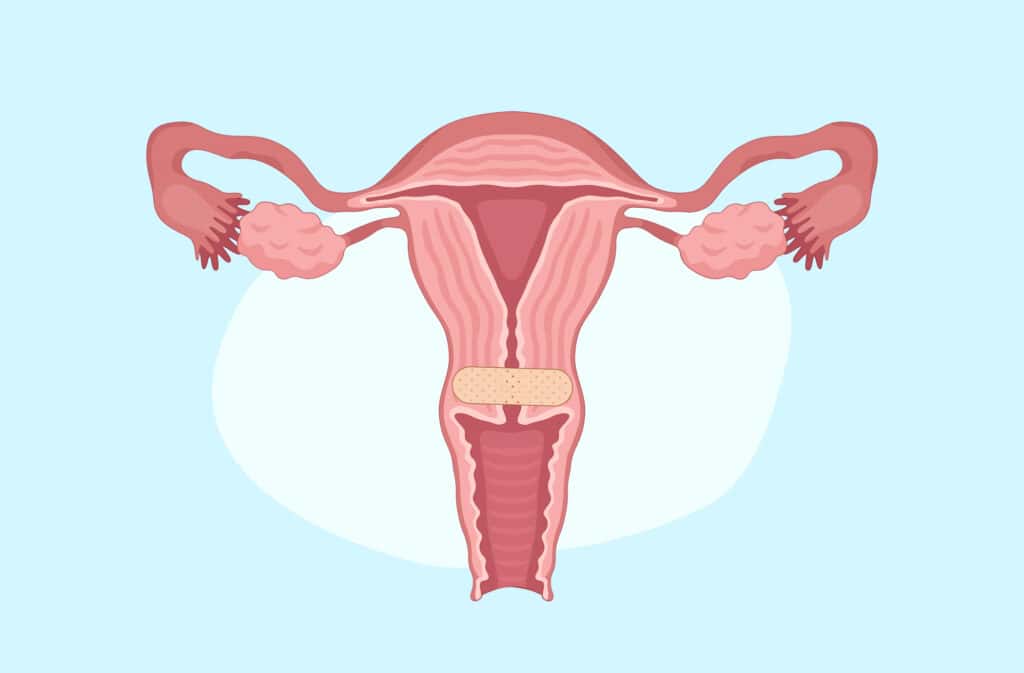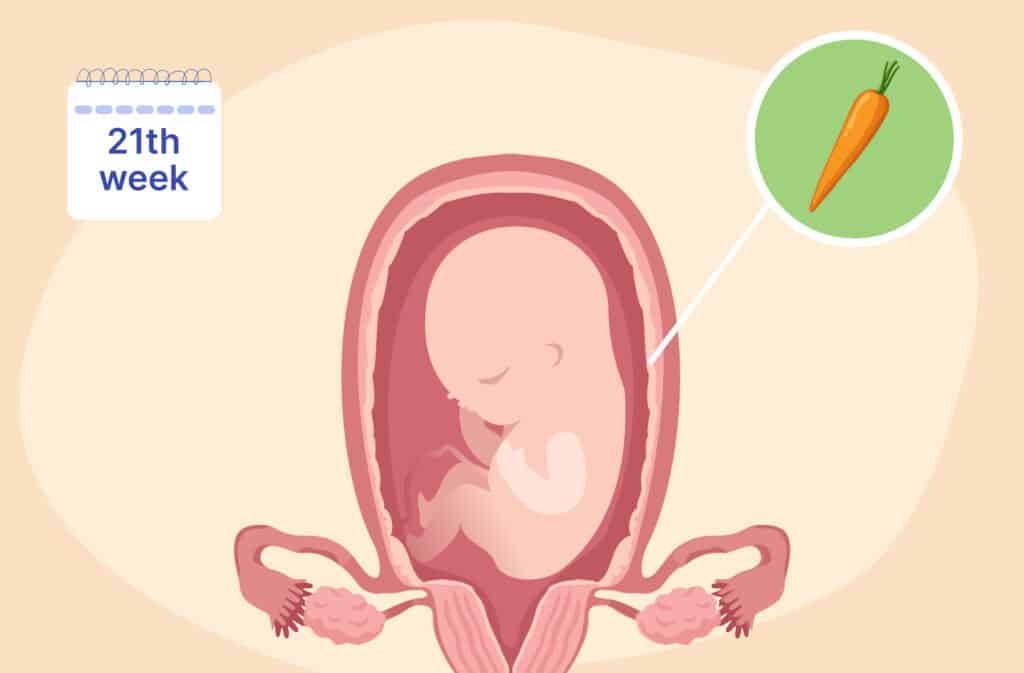Femia > Health Library > Pregnancy > Pregnancy week by week > 37 Weeks pregnant: Labor signs, baby development, and discomfort relief
37 Weeks pregnant: Labor signs, baby development, and discomfort relief

- Updated Feb 14, 2025
- Published
CRAFTED BY HUMAN
Crafted by human At Femia, we provide accurate and up-to-date information at every stage of your journey, from trying to conceive, pregnancy and postnatal support. All content is created by a real person based on in-depth research and own professional experience. Femia ensures that you will receive expert advice, strict accuracy and a personalized approach from our authors/medical experts. Learn more about our editorial policy.
FACT CHECKED
Fact checked At Femia Health, we maintain the highest standards of editorial excellence in delivering content focused on helping you conceive, guiding you through pregnancy, and supporting you postpartum. Explore our content review principles to learn how we ensure the accuracy and quality of our health and lifestyle tips for every stage of your journey.

Created with Hector Chapa, MD, FACOG, Clinical associate professor, Obstetrics and Gynecology Texas A&M University, College of Medicine in Bryan-College Station, USA
At 37 weeks pregnant, your baby is early term and preparing for birth. With just weeks (or days!) left to go, your baby weighs around 2.9 kilograms (6.4 pounds) and measures about 19 inches long. Focus on recognizing labor signs, managing discomfort, and finalizing your delivery plans.
You’ve reached 37 weeks pregnant, and your baby is considered early-term. This week is all about labor preparation, recognizing signs of labor, and managing late pregnancy symptoms. Let’s explore everything you need to know about week 37 of pregnancy.
Join thousands of moms-to-be who trust Femia for expert-backed
guidance during pregnancy and beyond
Pregnancy symptoms at 37 weeks
Here are common symptoms you may experience at 37 weeks:
Practice contractions
Braxton Hicks contractions, which feel like irregular, non-painful contractions, may become more frequent and intense as you near labor. While they can help prepare your cervix, it’s important to differentiate them from true labor contractions, which are more regular and painful. If contractions become regular or painful, seek medical advice.
Breasts leaking
Breast leakage in the final weeks of pregnancy is normal as your body produces colostrum, the first milk for your baby. If the leaking bothers you, using nursing pads can help absorb the discharge. Not leaking is also normal and doesn’t mean your breasts won’t be ready to nurse.
Vaginal discharge or spotting
As you near labor, increased vaginal discharge or spotting can occur. You may notice the mucus plug or “bloody show,” which happens as the cervix prepares for delivery. Contact your provider if you experience heavy bleeding, foul-smelling discharge, or constant leaking, as this could signal that your water has broken.
Feeling movement
Your baby’s movements should remain active, even if they become more noticeable or slightly uncomfortable. If you notice a significant decrease in movement, it’s essential to contact your provider immediately, as this could be a sign of distress.
Gas and bloating
At 37 weeks, your baby is putting pressure on your stomach and intestines, leading to gas, bloating, and indigestion. To alleviate these symptoms, try eating smaller meals, walking after meals, and avoiding gas-triggering foods. If discomfort becomes severe or includes blood, consult your provider.
Lower back pain
Back pain is common in the third trimester due to your growing baby and changes in posture. To relieve pain, try exercises like swimming or pelvic tilts, use proper posture, or schedule a prenatal massage. If the pain persists, seek medical advice for further treatment options.
Braxton Hicks contractions vs true labor
| Aspect | Braxton Hicks Contractions | True Labor |
|---|---|---|
| Frequency | Irregular, not progressively closer together | Regular intervals, getting closer together |
| Intensity | Weak, often described as mild discomfort | Increases in strength over time |
| Duration | Short, usually lasting less than 30 seconds | Longer, lasting 30-70 seconds per contraction |
| Location of Pain | Felt mainly in the front of the abdomen | Starts in the back and radiates to the front |
| Effect of Movement | Stops or decreases with activity or a change in position | Continues regardless of movement or position changes |
| Cervical Changes | Does not cause dilation or thinning of the cervix | Causes the cervix to dilate and thin out (effacement) |
Symptoms not to ignore at 37 weeks
- Severe or regular contractions. Consistent, painful contractions that increase in intensity and frequency could signal the onset of labor. If contractions become regular or are accompanied by other symptoms like lower back pain or pelvic pressure, it’s important to contact your healthcare provider immediately. These could be signs of preterm labor, and timely intervention is necessary.
- Decreased baby movements. A noticeable reduction in your baby’s movement, especially if it lasts for a significant period, could be a sign of fetal distress. It is crucial to monitor baby movements, and if you notice a decrease, you should immediately contact your provider. Decreased movement could indicate a need for further evaluation to ensure your baby’s well-being.
- Heavy vaginal bleeding. Heavy bleeding, similar to a period, could be a sign of a serious complication like placental abruption, where the placenta detaches from the uterine wall. This can cause severe consequences for both you and your baby. Any heavy bleeding should be reported to your healthcare provider immediately for proper monitoring and treatment.
- Severe headache or vision changes. Severe headaches, blurred vision, or sudden changes in vision can be signs of preeclampsia, a potentially dangerous pregnancy complication. If you experience any of these symptoms, it’s critical to seek medical attention promptly. Preeclampsia can lead to serious risks for both mother and baby, including seizures and organ damage if left untreated.
- Watery vaginal discharge. If you notice a sudden gush of clear fluid or consistent leaking, this could signal that your water has broken. It’s essential to contact your healthcare provider right away, as premature rupture of membranes can lead to infection or preterm labor. Your provider will guide you on next steps, including whether labor is imminent or if further interventions are needed.
- Bleeding like a period. While lighter bleeding, often associated with the mucus plug, is common and typically not alarming, heavy bleeding resembling a period is a red flag and requires immediate medical attention. This could indicate a miscarriage or placental issue, and your healthcare provider will need to assess your condition to ensure proper care and next steps.
Your body at 37 weeks pregnant
At 37 weeks pregnant, your body is in the final stages of preparation for labor. As your baby continues to grow and move into the birth position, you may feel an increase in pelvic pressure, which is a result of your baby’s head moving lower into your pelvis. This pressure can make it harder to walk or get comfortable, but it’s a normal part of the process. You may also experience more frequent Braxton Hicks contractions as your body practices for the real thing. These practice contractions help your uterus prepare for the intensity of labor, and while they can be uncomfortable, they are usually not painful.
Fatigue is another common experience at this stage, as your body is working hard to support the baby’s growth and prepare for delivery. Your energy reserves are being used up as your body goes through numerous physical changes to get ready for labor. It’s important to rest when possible, as your body will need all the energy it can get when labor begins. Many women also feel an emotional surge, sometimes a mix of excitement and anxiety, as they await the arrival of their baby. It’s essential to stay positive, stay connected with your support system, and continue preparing mentally and physically for the upcoming birth.
37 Weeks in months
You are approximately 9 months pregnant, with just three weeks to go until your due date. A due date (as calculated from the first day of the last period) is 40 weeks. The end of pregnancy should be by 42 weeks.
37 Weeks pregnant belly
Your belly may feel heavier as your baby settles lower into your pelvis, a process called “lightening.” This can ease pressure on your lungs but increase discomfort in your pelvis.
Baby development at 37 weeks
At 37 weeks, your baby is considered early-term, and their development is nearly complete. They are now fully developed, with fully matured organs and systems, but they will continue to gain weight and store fat to prepare for life outside the womb. Your baby is busy practicing essential life skills like breathing, sucking, and swallowing, which will help them adapt to feeding and breathing once born. Their lungs are ready to function outside the womb, and they are also developing more fat to help regulate their body temperature after birth.
Baby at 37 weeks
- Weight: Around 2.9 kilograms (6.4 pounds), roughly the weight of a small cabbage.
- Length: Baby size is approximately 19 inches long, similar in size to a Swiss chard.
Movements
As space in the womb becomes limited, you may notice your baby’s movements becoming slower but more deliberate. These movements may feel stronger, as your baby is now less able to move freely but still practicing stretching, kicking, and rolling. While it might seem like there’s less space for them to move, they are still making their presence known with strong, purposeful motions.
This week marks a key milestone as your baby is nearly ready for life outside the womb, although they will continue to grow and fill out in the coming weeks. The next few days or weeks are crucial as your baby gets stronger and prepares for the birth process.
37-Week ultrasound
A 37-week ultrasound may be performed to check your baby’s position, amniotic fluid levels, and overall health. This scan can also confirm your baby’s readiness for birth.
Tests to expect at 37 weeks pregnant
Your provider will monitor your health and your baby’s progress with routine tests:
- Blood pressure check: Screens for preeclampsia or hypertension.
- Urine test: Detects protein and glucose levels to rule out complications.
- Fetal heartbeat and movements: Ensures your baby remains healthy and active.
- Cervical check: Your provider may check for dilation and effacement to assess labor progress.
- Group B strep (GBS) test: Ensures you’ll receive antibiotics during labor if needed. It is routine to collect a vaginal and rectal swab test for GBS from 36 weeks until 37 weeks 6 days. This is not an STI but part of the normal bacteria in some women.
Join thousands of moms-to-be who trust Femia for expert-backed
guidance during pregnancy and beyond
37 weeks pregnant: Symptoms of labor
As you approach your due date, it’s important to be aware of the signs that labor could be starting. While some symptoms may be a normal part of pregnancy, others may indicate that labor is imminent. Here are some common symptoms to look out for:
Regular contractions
If you’re experiencing contractions that come at regular intervals, this may be the beginning of labor. Unlike Braxton Hicks contractions, which are often irregular and less painful, labor contractions become more intense, regular, and closer together over time. You should contact your healthcare provider if contractions are coming every 5-10 minutes and are getting stronger.
Water breaking
If your water breaks, this is a clear sign that labor is starting. Amniotic fluid may leak out as a trickle or in a large gush. The fluid is typically clear or slightly yellowish and odorless. If you notice a change in discharge or suspect your water has broken, call your healthcare provider right away.
Bloody show
As your cervix begins to dilate and efface, you may notice some light bleeding or a brownish discharge, also known as the “bloody show.” This is often a sign that labor is approaching. If the bleeding is heavy, or if you notice bright red blood, contact your healthcare provider immediately.
Lower back pain
Intense lower back pain, often accompanied by cramps, can indicate that labor is near. As the baby moves down into the birth canal, it puts pressure on the lower back, which can lead to discomfort. Persistent back pain or cramps that don’t go away may signal early labor.
Pelvic pressure
As your baby drops lower into your pelvis in preparation for birth, you may feel increased pressure in the pelvic area. This can make walking or even sitting uncomfortable. Pelvic pressure is a normal part of late pregnancy, but if it’s accompanied by other signs of labor, it’s time to contact your doctor.
Cervical dilation
Your healthcare provider may perform a pelvic exam to check if your cervix has started to dilate. As labor approaches, your cervix will soften and open to allow your baby to pass through. If you’re noticing cervical dilation, it’s a sign that labor may be imminent.
Keep an eye out for these symptoms as you near the end of your pregnancy, and always reach out to your healthcare provider if you’re unsure whether labor is starting.
How dilated should I be at 37 weeks?
Cervical dilation varies greatly at 37 weeks. Some women may be slightly dilated (1-2 cm), while others remain closed. Dilation doesn’t always predict when labor will start, so stay in close contact with your provider.
👉Find out more:
Health tips and self-care at 37 weeks pregnant
At 37 weeks, your body is in the final stages of preparation for labor. It’s essential to stay mindful of your well-being while focusing on tasks that will ease your transition into motherhood. Here are some self-care tips to support your physical and emotional health during this stage.
Prepare for labor
Preparation is key for labor. Review your birth plan with your doctor or midwife, and make sure you have everything ready for the big day, including your hospital bag and transportation. Practice relaxation techniques such as deep breathing, meditation, or visualizations to help calm your nerves and stay focused. Educate yourself on the stages of labor and what to expect so that you feel empowered and informed. If you haven’t already, consider attending any prenatal classes or reviewing the birth process to ensure you’re mentally and physically prepared.
Stay hydrated
Staying hydrated is essential for supporting your body’s increased blood volume and managing swelling. Drinking enough water can also help reduce contractions that may arise from dehydration. Aim for at least 8-10 cups of water per day, and try to avoid excessive caffeine, which can contribute to dehydration.
Rest and relax
At 37 weeks, you may experience fatigue as your body is working hard to prepare for labor. Taking breaks and resting is crucial. Nap during the day if you need to, and focus on relaxing in the evenings. Consider light stretching, prenatal yoga, or relaxation techniques like deep breathing to ease stress and help with sleep. If you find it difficult to sleep, try using pillows to prop up your body and support your growing belly for comfort.
Monitor baby movements
Although your baby is growing and may be running out of room, it’s important to continue monitoring their movements. Pay attention to their activity patterns, and if you notice a significant decrease in movement, contact your healthcare provider immediately. This can be a sign of distress or other complications, so it’s essential to stay in touch with your provider and trust your instincts.
Relieve swelling
Swelling in your feet, ankles, and hands is common in the final weeks of pregnancy. To help alleviate this, elevate your feet when sitting or lying down, and avoid standing for extended periods. Wearing compression stockings can also help with circulation. Try gentle exercises like walking or swimming to encourage blood flow and reduce swelling.
Pelvic floor exercises
Strengthening your pelvic floor muscles through Kegel exercises can prepare your body for labor and delivery. These exercises help increase the flexibility and strength of the muscles that support your uterus, bladder, and rectum. Regular pelvic floor exercises can also reduce the risk of incontinence and help with recovery after childbirth.
Monitor for signs of preterm labor
At 37 weeks, it’s important to stay vigilant for any signs of preterm labor. Keep an eye out for regular contractions that are becoming stronger and closer together, pelvic pressure, or changes in vaginal discharge. If you experience any of these symptoms or have concerns, contact your healthcare provider immediately to rule out early labor.
By focusing on hydration, rest, and preparation for labor, you can support your body during this exciting and challenging time. Self-care at 37 weeks is essential to ensure that you are physically and mentally ready for the birth of your baby.
Questions from the Femia community
How to relieve hemorrhoid discomfort?
Use a warm sitz bath to soothe inflammation and reduce discomfort. Applying witch hazel pads or over-the-counter creams can provide additional relief. Staying hydrated and eating high-fiber foods can help prevent constipation, which worsens hemorrhoids.
What should I expect during a cervical check?
A cervical check involves your provider measuring how dilated (open) and effaced (thinned) your cervix is. It’s usually quick and may feel uncomfortable but helps assess your labor progress.
How can I stay comfortable at night with pelvic pain?
Use a pregnancy pillow to support your hips and knees while sleeping on your side. Try gentle stretches before bed and avoid sleeping in one position for too long.
How likely is it to go into labor at 37 weeks?
At 37 weeks, you're considered "early-term." While some women may go into labor, others may carry on for a few more weeks, as labor timing can vary.
How to tell if baby will come early?
Signs of early labor include frequent, painful contractions, back pain, pelvic pressure, and changes in vaginal discharge. Consult your healthcare provider if you notice these symptoms.
Why am I cramping but not going into labor?
Cramping can occur due to Braxton Hicks contractions, digestive issues, or stretching as your body prepares for labor. These cramps are usually irregular and not an indication of true labor.
The bottom line
At 37 weeks pregnant, your baby is early-term and nearly ready for delivery. An ultrasound may be performed to check your baby’s position, amniotic fluid levels, and overall health. This scan can also confirm your baby’s readiness for birth. Focus on monitoring labor signs, managing discomfort, and preparing for the exciting days ahead as you get closer to meeting your baby.
References
- “37 Weeks Pregnant: Symptoms, Baby Development & Tips.” BabyCenter, www.babycenter.com/pregnancy/week-by-week/37-weeks-pregnant.
- “Week 37 of Pregnancy: Symptoms, Baby Development & More.” What to Expect, www.whattoexpect.com/pregnancy/week-by-week/week-37.aspx.
- “37 Weeks Pregnant: Baby Development, Symptoms & Tips.” NHS, www.nhs.uk/pregnancy/week-by-week/1-to-12/37-weeks/.
- “Pregnancy Week 37: What to Expect.” American Pregnancy Association, www.americanpregnancy.org/healthy-pregnancy/week-by-week/37-weeks-pregnant/.

Discover the difference between Braxton Hicks vs contractions. Learn how to identify practice contractions and the best ways to manage them.

How can your cervix get bruised and what are the telltale signs? Learn how to recognize bruised cervix symptoms after sex and know when to seek help.

Discover what happens at 21 weeks pregnant, from baby size and ultrasound insights to symptoms and health tips for mom and baby.
